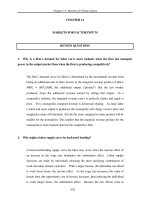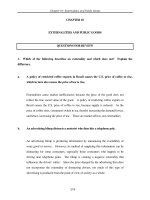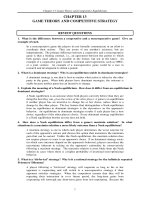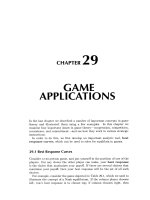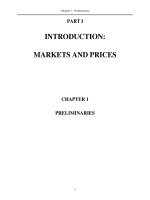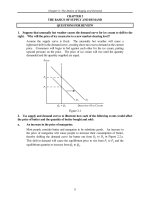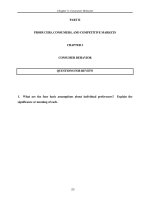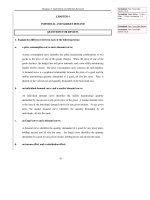Câu hỏi đánh giá môn Kinh tế vĩ mô bằng tiếng Anh- Chương 16
Bạn đang xem bản rút gọn của tài liệu. Xem và tải ngay bản đầy đủ của tài liệu tại đây (74.93 KB, 8 trang )
Chapter 16: General Equilibrium and Economic Efficiency
255
PART IV
INFORMATION, MARKET FAILURE,
AND THE ROLE OF GOVERNMENT
CHAPTER 16
GENERAL EQUILIBRIUM AND ECONOMIC EFFICIENCY
QUESTIONS FOR REVIEW
1. Why can feedback effects make a general equilibrium analysis substantially different
from a partial equilibrium analysis?
A partial equilibrium analysis focuses on the interaction of supply and demand for
one market. It ignores the influences that shifts in supply and demand in one
market might have on the markets for complements and substitutes. A general
equilibrium analysis takes feedback effects into account, where a price or quantity
adjustment in one market can cause a price or quantity adjustment in related
markets. Ignoring these feedback effects can lead to inaccurate forecasts of the
full effect of changes in either supply or demand. An initial shift in demand in one
market, for example, can cause a shift in demand in a related market, which can
then cause a second shift in demand in the first market. A partial equilibrium
analysis will stop at the first initial shift whereas a general equilibrium analysis will
continue on and look at possible shifts in demand in related markets. Although
analysis should incorporate all feedback effects, one task of the economist is to
determine the markets that are most closely related to the market of primary
Chapter 16: General Equilibrium and Economic Efficiency
256
concern. Attention is directed toward these markets, thus enabling better forecasts
of changes in equilibrium prices and quantities.
2. In the Edgeworth box diagram, explain how one point can simultaneously represent the
market baskets owned by two consumers.
The Edgeworth box diagram allows us to represent the distribution of two goods
between two individuals. The box is formed by inverting the indifference curves
of one individual and superimposing these on the indifference curves of another
individual. The sides of the box represent the total amounts of the two goods
available to consumers. On the vertical axis, we read off the amount to each
individual as the difference between the horizontal axis and the point. For one
individual, this is the distance from the bottom of the box to the top, and for the
other, this is the distance from the top of the box to the bottom. Similarly, the
horizontal axis represents amounts of a second good distributed to the two
individuals. Each point in the box represents a different allocation of the two
goods between the two individuals.
3. In the analysis of exchange using the Edgeworth box diagram, explain why both
consumers’ marginal rates of substitution are equal at every point on the contract curve.
The contract curve, in the context of an Edgeworth box diagram, is the set of points
where the indifference curves of the two individuals are tangent. We know that
the marginal rate of substitution is equal to the (negative) slope of the indifference
curves. Also, when two curves are tangent at a point, their slopes are equal at that
point. Thus, by defining the contract curve as a set of indifference curve
tangencies, the marginal rates of substitution between the two goods are equal for
the two individuals given we assume convex indifference curves.
4. “Since all points on a contract curve are efficient, they are all equally desirable from a
social point of view.” Do you agree with this statement? Explain.
Chapter 16: General Equilibrium and Economic Efficiency
257
If society is only concerned with efficiency and not with equity, then all points on
the contract curve are equally desirable. Since it is impossible to make
comparisons of utility between individuals, economics focuses on efficiency. But,
if we are also concerned with equity (i.e., whether the final allocation is fair), then
all points on the contract curve are not equally desirable.
5. How does the utility possibilities frontier relate to the contract curve?
Since each point in an Edgeworth box can be compared to every other point by each
individual, individuals can assign a preference ordering to all points. This
preference ordering is the utility function. We can graph these preferences with
levels of satisfaction (utility) for one individual on one axis and levels of
satisfaction for a second individual on the other axis. (Of course, more than two
individuals can be represented with more axes.) The utility-possibility frontier
shows the levels of satisfaction achieved by each of two individuals when they have
traded to an efficient outcome on the contract curve. While points that lie between
the origin and the utility-possibility frontier are feasible they are not efficient
because further trading will leave one individual better off without making the other
individual worse off. Points outside the frontier are not feasible unless the
individuals are given greater amounts of one or both goods.
6. In the Edgeworth production box diagram, what conditions must hold for an allocation
to be on the production-contract curve? Why is a competitive equilibrium on the contract
curve?
When constructing an Edgeworth box for the production of two goods with two
inputs, each point in the box represents an allocation of the two inputs between the
two production processes. With production, each point can be ordered according
to the total output. These points lie on isoquants instead of on indifference curves.
Since each point simultaneously represents the allocation of inputs to two
production processes, it lies on two isoquants, one for each production process.
Chapter 16: General Equilibrium and Economic Efficiency
258
The production contract curve represents all combinations of inputs that are
technically efficient. Thus, there would be no way to increase the output of one
good without decreasing the output of the other good.
A competitive equilibrium is one point on the production-contract curve. It is the
intersection of the production-contract curve and a line passing through the initial
allocation with a slope equal to the ratio of prices. (The ratio of prices dictates the
rates at which inputs can be traded in the market.) For a competitive equilibrium
to hold, each producer must use inputs so that the slopes of the isoquants are equal
to one another and also equal to the ratio of the prices of the two inputs.
Therefore, the competitive equilibrium is efficient in production. (This
equilibrium assumes convex indifference curves.)
7. How is the production-possibilities frontier related to the production contract curve?
We can graph the quantities of each good produced (each point in the Edgeworth
box) on a two-dimensional graph, where the vertical axis represents the output of
one good and the horizontal axis represents the output of the other good. The
production-contract curve is represented in this two-dimensional graph as the
production possibilities frontier. Points inside this frontier are feasible but
inefficient. Points outside the frontier are infeasible and only attainable when more
inputs become available or production processes become more efficient. Points on
the production-possibilities frontier are the same as those on the production-contract
curve. The difference is that the production-contract curve measures inputs on the
axes and the production-possibilities frontier measures outputs on the axes.
8. What is the marginal rate of transformation (MRT)? Explain why the MRT of one
good for another is equal to the ratio of the marginal costs of producing the two goods.
The marginal rate of transformation, MRT, is equal to the absolute value of the
slope of the production possibilities frontier, and measures how much of one output
Chapter 16: General Equilibrium and Economic Efficiency
259
must be given up to produce one more unit of the other output. The total cost of
all inputs is the same at each point on the production possibilities frontier because
we use the same total amount of all inputs, and merely allocate them differently
along the frontier. Therefore, when we move down along the frontier, the cost of
producing one output is reduced by the same amount that the cost of producing the
other output is increased. Suppose the MRT is 4 in absolute value terms, then we
must give up 4 units of the output on the vertical axis to get one more unit of output
on the horizontal axis. This means that the total cost of producing the 4 units is the
same as the total cost of producing the one unit, or that the marginal cost of the
good on the horizontal axis is 4 times the marginal cost of the good on the vertical
axis.
9. Explain why goods will not be distributed efficiently among consumers if the MRT is not
equal to the consumers’ marginal rate of substitution.
If the marginal rate of transformation, MRT, is not equal to the marginal rate of
substitution, MRS, we could reallocate inputs in producing output to leave the
consumers and producers better off. If the MRS is greater than the MRT then
consumers are willing to pay more for another unit of a good than it will cost the
producers to produce another unit of the good. Both can therefore be made
better off by arranging a trade somewhere between what consumers are willing to
pay and what the producers have to pay to produce the extra unit. Note also that
when MRT
≠
MRS, the ratio of marginal cost will not be equal to the ratio of
prices. This means that one good is being sold at a price below marginal cost
and one good is being sold at a price above marginal cost. We should increase
the output of the one good whose price is above marginal cost and reduce the
output of the other good whose price is below marginal cost.
10. Why can free trade between two countries make consumers of both countries better off?
